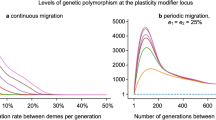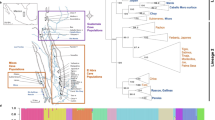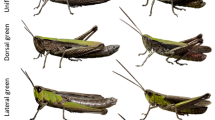Abstract
Little is known of how the large amount of genetic variation found in natural populations is maintained. Diversifying natural selection in a heterogeneous environment has great potential for promoting genetic polymorphism1. If one allele is favoured in one microhabitat and the alternative allele in another (which may be separated from the first by space or time), the disruptive effects of selection can maintain both alleles in the population. The limiting conditions of niche size, selective intensity and gene flow which could in theory maintain polymorphism in this way have been widely discussed2,3. This mechanism is much more effective in promoting genetic diversity if carriers of the alternative alleles are able to select the niche in which their fitness is greatest4. Here we explore the properties of a system in which two Drosophila eye colour alleles, known to show differences in fitness, are given the opportunity to select different microhabitats in a population cage. It seems that habitat selection in a heterogeneous environment can lead to the maintenance of polymorphism for an allele which is disadvantageous in either habitat when no opportunity for choice is available.
This is a preview of subscription content, access via your institution
Access options
Subscribe to this journal
Receive 51 print issues and online access
$199.00 per year
only $3.90 per issue
Buy this article
- Purchase on Springer Link
- Instant access to full article PDF
Prices may be subject to local taxes which are calculated during checkout
Similar content being viewed by others
References
Levene, H. Am. Nat. 87, 331–333 (1953).
Maynard Smith, J. & Hoekstra, R. Genet. Res., Camb. 35, 45–57 (1980).
Hedrick, P. W., Ginevan, M. E. & Ewing, E. P. A. Rev. Ecol. Systematics 7, 1–32 (1976).
Taylor, C. E. Genetics 83, 887–894 (1976).
Waddington, C. H., Woolf, B. & Perry, M. Evolution 8, 89–96 (1954).
Markow, T. A. & Scavarda, N. J. Behav. Genet. 7, 139–146 (1977).
Rockwell, R. F. & Seiger, M. B. Am. Scient. 61, 339–345 (1973).
Chabora, P. C. & Kessler, M. E. Behav. Genet. 7, 281–290 (1977).
Reed, S. C. & Reed, E. W. Evolution 4, 34–42 (1950).
Grossfield, J. Proc. natn. Acad. Sci. U.S.A. 68, 2669–2673 (1971).
Da Cunha, A. B. & Dobzhansky, Th. Evolution 8, 119–134 (1954).
Van Valen, L. Am. Nat. 99, 377–390 (1965).
McDonald, J. F. & Ayala, F. J. Nature 250, 572–574 (1974).
Powell, J. R. Science 174, 1035–1036 (1971).
Taylor, C. E. & Powell, J. R. Genetics 85, 681–695 (1977).
Stalker, H. D. Genetics 82, 323–347 (1976).
Boardman, M., Askew, R. R. & Cook, L. M. J. zool. Res. 172, 343–355 (1974).
Giesel, J. T. Evolution 24, 98–119 (1970).
Schoener, T. W. & Schoener, A. Evolution 30, 650–658 (1976).
Christensen, B. Hereditas 87, 21–26 (1977).
Cavener, D. Behav. Genet. 9, 359–365 (1979).
Author information
Authors and Affiliations
Rights and permissions
About this article
Cite this article
Jones, J., Probert, R. Habitat selection maintains a deleterious allele in a heterogeneous environment. Nature 287, 632–633 (1980). https://doi.org/10.1038/287632a0
Received:
Accepted:
Issue Date:
DOI: https://doi.org/10.1038/287632a0
This article is cited by
-
Witnessing Phenotypic and Molecular Evolution in the Fruit Fly
Evolution: Education and Outreach (2012)
-
Genotype-specific habitat selection and thermal ecology in Nucella lapillus (L.) (the dogwhelk)
Heredity (1995)
-
Maintenance of two genetic entities by habitat selection
Evolutionary Ecology (1995)
-
Polymorphism in heterogeneous environments, evolution of habitat selection and sympatric speciation: Soft and hard selection models
Evolutionary Ecology (1993)
-
Soft selection and quantitative genetic variation: a laboratory experiment
Heredity (1991)
Comments
By submitting a comment you agree to abide by our Terms and Community Guidelines. If you find something abusive or that does not comply with our terms or guidelines please flag it as inappropriate.



